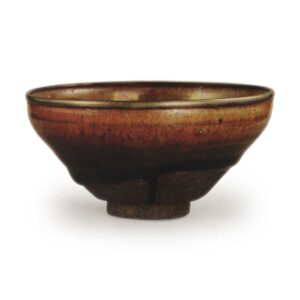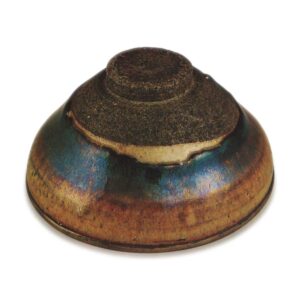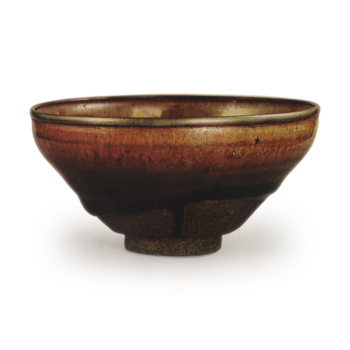

Chuko Meibutsu
Height: 6.1-6.2cm
Diameter: 12.2-12.4cm
Outer diameter of foot ring: 4.3cm
Height of foot ring: 0.8cm
The calligraphy on the box is by Kobori Enshu, and it says “chrysanthemum”. The glaze is yellow around the rim and then becomes black towards the base, and this is said to resemble the feathers of a swallow, hence the name. The box also has the character “monkey” on it, meaning that it is one of the 12 zodiac signs of the Enshu-possession Tenmoku. In the tea books, it is described as Seto or Fujishiro ware based on the glaze, and the Taisho Meiki Kan (A Guide to Famous Tea Bowl) also arranges it among the Seto Tenmoku, but it is actually a clear Chinese Tenmoku, and this kind of misidentification seems to have occurred frequently in the past. This tea bowl is described as a yellow Tenmoku in the accompanying bag, and it seems that this kind of misidentification has occurred frequently in the past. This tea bowl is described in the accompanying bag as a yellow tenmoku, and should be seen as a type of yellow tenmoku, and it also has characteristics that are similar to haikyo.
The clay is hard and tightly fired to a grayish-white color, and feels rough and coarse to the touch, with small stones visible where it has been chewed. The shape is slightly shallower than usual, and the foot ring is chamfered at the edge of the flat bottom, with a sharp, right-angled rise, a form commonly seen in haikyo and kitenmoku. There are traces of red characters on the bottom, but they are faint and cannot be read.
The glaze is a sober yellow inside and out, with a hint of green in places, and it gradually thickens from the transparent rim downwards, becoming a dark brown candy glaze as it flows downwards, and forming a thick, dark black pool at the waist on the outside. In the middle of the thick black glaze layer, there is a pattern of grains on the inside and outside, and on the outside, especially around the glaze pool, there is a beautiful iridescent luster on the surface. This is a type of kiln effect, and it is thought that certain metallic crystals have risen to the surface of the glaze. Also, a thin, white glaze layer can be clearly seen on the black glaze around the waist. This is a cosmetic glaze applied under the yellow glaze, and part of it has appeared at the edge of the glaze. When the clay is rough and has a grayish tinge, this is a technique used to make the transparent yellow glaze look more beautiful, and is a technique that is always seen in yellow tenmoku and haikyo. However, here the jet-black parts and the single white line stand out clearly, creating a rather stylish effect. The name Tsubame seems to have been inspired by this part of the piece. The rim is sand-glazed.
In addition, the following article can be found in the Chasho.
Fukitenmoku: This Tenmoku bowl was made by Fujishiro, and it has a metallic sheen like that of wild wood or sea cucumber skin. The clay is covered in a water-based glaze, and it is a tea bowl of unparalleled beauty.
Heron Tenmoku: Kobori This Tenmoku is as good as the Kinzan Yamaki Tenmoku, and it looks like it was made by Fujishiro. It is the 12th of the Chinese zodiac, the Monkey.
One hawk tenmoku, chrysanthemum tenmoku, tapping swallow tenmoku, and this tenmoku, which was made in the fourth year of the Kan’ei era, was bought from the Kobori family in Osaka by Matayoshi (Tsubakian Bunko Ko 16th issue)
The accompanying item is a white ground, gold-lacquered, peony-patterned, double-walled tea caddy with a single piece of old cloth from the accompanying bag inserted into the lid. The current bag is made of satin with a plum-blossom pattern. The inner box is made of paulownia wood, and the writing on it is by Enshu, but the character for “monkey” seems to have been added later. It is accompanied by a red lacquered ring-shaped tenmoku stand, and the writing on the box is also by Enshu, and it says “Rika Goshun”.
It was originally owned by Kobori Enshu. In 1775, it entered the Chigusa-ya Hirase family, and in 1903, it was sold at auction as part of the Hirase family collection, and it has been in the Sumitomo family collection ever since.



